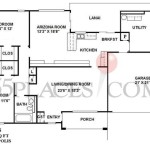Simple One Floor House Plans: A Guide to Creating a Functional and Stylish Home
One-floor house plans offer an array of benefits that make them an attractive choice for many homeowners. From ease of access and energy efficiency to improved safety and a seamless flow of living spaces, it's no wonder these designs are gaining popularity. Whether you're a first-time homebuyer, a retiree seeking a low-maintenance lifestyle, or simply someone who prefers the convenience of single-level living, this guide will provide valuable insights into creating a simple yet functional and stylish one-floor home. ### 1. Consider Your Lifestyle and Needs The first step in designing a simple one-floor house plan is to carefully consider your lifestyle and needs. Take into account the number of bedrooms and bathrooms you'll require, as well as any specific features or spaces that are important to you. Do you need a dedicated home office or a spacious family room? Are you an avid cook who desires a gourmet kitchen? By defining your priorities, you can ensure that your house plan caters to your unique lifestyle and enhances your daily routine. ### 2. Prioritize Open and Flowing Spaces One-floor house plans often emphasize open and flowing spaces to create a sense of spaciousness and connectivity between different areas of the home. An open floor plan typically combines the living room, dining room, and kitchen into one large, cohesive space. This layout promotes easy movement, interaction, and a seamless transition between activities. Whether you're entertaining guests or simply spending time with family, an open floor plan fosters a sense of togetherness and encourages a relaxed, casual lifestyle. ### 3. Maximize Natural Light and Ventilation Incorporating natural light and proper ventilation into your one-floor house plan is crucial for creating a healthy, comfortable, and energy-efficient home. Position windows and doors strategically to capture the sun's warmth and natural light, reducing the reliance on artificial lighting during the day. Cross-ventilation, achieved by placing windows and doors on opposite sides of the house, promotes air circulation, minimizing the need for air conditioning. These design elements contribute to a brighter, more inviting living environment while reducing energy bills and enhancing overall well-being. ### 4. Efficiently Arrange Functional Spaces When designing a simple one-floor house plan, it's essential to arrange the functional spaces efficiently to optimize functionality and minimize wasted space. Group similar functions together, such as placing the kitchen, dining room, and pantry in close proximity. Position bedrooms and bathrooms in a separate wing of the house to create a private and quiet sleeping area. Carefully consider the flow of movement between spaces, ensuring smooth transitions and eliminating unnecessary steps. By thoughtfully planning the layout, you can create a home that is both practical and efficient. ### 5. Embrace Simplicity and Minimalism Simple one-floor house plans often embrace a minimalist design aesthetic, characterized by clean lines, neutral colors, and a focus on functionality. This approach creates a sense of order and tranquility, allowing the home's natural beauty and architectural features to take center stage. By avoiding unnecessary ornamentation and clutter, you can enhance the spaciousness and airiness of your home. Embrace simplicity in both the overall design and the selection of furnishings and décor to create a serene and inviting living environment. ### 6. Personalize Your Home with Unique Touches While simplicity and functionality are key principles in simple one-floor house plans, it's also important to add personal touches that reflect your unique style and personality. Incorporate elements that make your home feel cozy and inviting, such as a fireplace in the living room, a reading nook in the master bedroom, or a built-in window seat in the kitchen. Choose furnishings and décor that resonate with your taste and preferences, creating a space that truly feels like home. ### 7. Consider Future Adaptability and Accessibility When designing your one-floor house plan, think about future adaptability and accessibility. Consider features that can easily be modified or adapted as your needs change over time. For example, incorporating wider doorways and hallways can accommodate potential mobility aids in the future. Additionally, consider the placement of electrical outlets and switches to ensure they are accessible from a seated position. These thoughtful considerations will ensure your home remains comfortable and functional for years to come. By following these guidelines and working with a qualified architect or home designer, you can create a simple one-floor house plan that meets your lifestyle needs, enhances your daily routine, and reflects your personal style. Whether you're seeking a cozy and efficient space for a small family or a spacious and open layout for entertaining, a well-designed one-floor home offers a harmonious blend of simplicity, functionality, and elegance.
Easy Simple Floor Plan 49 For Home Decor Ideas With Small House Plans Country

Simple One Story 3 Bedroom House Plans Modular Home Floor 1200 Sq Ft

Simple One Story House Plan 80631pm Architectural Designs Plans

Picture Of One Bedroom Single Story Residence In 60 M² Lot House Floor Plans Roof Design Small

Cecile One Story Simple House Design Pinoy Plans

Simple House Plans Blog Homeplans Com

Small One Story 2 Bedroom Retirement House Plans Houseplans Blog Com
House Plan Of The Week Simple One Story Design Builder

Simple House Plans Clutter Free 3 Bedroom Nethouseplansnethouseplans

Single Story 1 Bedroom Deceptively Simple Contemporary House Plan








